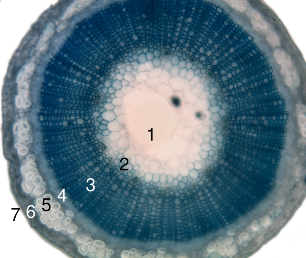 Virginia Pine
Virginia Pine
Pinus virginiana
W
hat Doesn't Kill You Makes You Stronger!How did plants adapt to
live on land?
Plants' cells needed to develop stomata in their cells walls to
hold in, and release water and nutrients when needed. Because
the early ancestor of plants, algae, contained chloroplasts, it
was easy to photosynthesize. This trait was passed on to the
land plants, and therefore plants were adapted to making their
own food. The soil is rich with a wide variety of minerals and
nutrient, so the plants had to develop a structure that could
help them to use these nutrients to their advantage. The roots
anchor the plant to the soil, and also allow for the uptake of
important nutrients and minerals.
 How
were plants able to grow upwards, far from the soil and water
supply?
How
were plants able to grow upwards, far from the soil and water
supply?
Plants like the Virginia Pine developed vascular tissues, which
are cells joined into tubes that transport nutrients and water
through the plant's body. These tissues use capillary action to
transport the water and nutrients up from the roots all the way
to the top and tips of the tree. They grow with the tree, and
never limit the growth. These specialized tissues allowed plants
to grow upwards and in diameter, assuring that the entire plant
will get enough supply of nutrients to help it survive.
How did the
Virginia Pine adapt?
Although the Virginia Pine
doesn't do well in the shade because the
seedlings can't be established; they can
grow in very poor land sites. They grow
after fire and erosion! This is because
these trees have the ability to use all
the nutrients in the soil to revive and
grow again. Although many of the
smaller trees will burn completely in
fires, the larger trees have the
adaptation to survive! This is because
the tissues in the tree are fire
resistant and have most likely survived
more than one fire. The bark is thin but
older trees have the ability to reform
their dominant buds located on the stems
and branches, and can revive their roots
back to normal. Also, the seed
protection and basal sprouting at a
young age help these trees to be more
fire tolerant, and allow the seedlings
to regenerate. A site disturbance of
fire can actually triple the amount of
germination more than an undisturbed
seedbed.
Visit the Forest Encyclopedia for more information
The Virginia Pine also
has shallow roots, which allow them to
receive water and nutrients faster
through the roots, and pass them on
throughout the entire tree. Also, the
ethylene that is stored in the seedlings
of a Virginia Pine help allow for more
efficient growth and survival. The
Virginia pine has adapted to the poor
site conditions and are able to develop
in sand and clay loam, gravel, sandy
soil, and other dry environments. This
is because it's tissues are specialized
in using up and storing nutrients, from
any sources of soil, preferably dry
environments though. The seedlings
thrive in areas of total sunlight, and
are also extremely tolerant to the
dry sites and conditions. They can store
nutrients and water very well, which
only means good things for them!
 What
are special adaptations of a pine
needle?
What
are special adaptations of a pine
needle?
The Pine needle is extremely
compacted and surrounded by a hard
casing. This holds in an unbelievable
amount of water and nutrients. The
needles are green because they contain
chloroplasts which aid in
photosynthesis. They also maximize the
surface area, so that they can gain as
much food and nutrients from
photosynthesis as possible. The
Virginia Pine never has a point when
there are no needles on the branches, so
they have a continuous source of
photosynethesis.
Pine Needles Lodge and Golf Course
Here's a great place to stop by!
What about the special adaptations of
the pine cone?
The male cone, or pollen cone is
clustered, compacted, and tough.
Although they are small and contain
thousands of microspores, the pollen
cones deteriorate quite quickly.
The female cone, or ovulate cone is
larger and survives much longer. They
form multiple scales, and each scale
contains two ovules which eventually
turn into seeds These scales are hard
and protect the ovules. The most
important adaptations that these cones
made, is the ability to fertilize
without the help of other organisms.
Pines can fertilize simply by the wind,
and they do not require water like early
plants need to
reproduce.
Visit here for more information on Pine Cones!
The Signals are detected by protein receptors within the cells, and change their shape in response to that certain stimulus. In the sunlight, phytochrome, a photoreceptor specialized in detecting light, is in charge of the reaction. The response is a regulation of one or more cellular actions. Most of the time it involves an increase of activity in certain enzymes. These responses take place within the plant for the purpose of the plant trying to become more stable and normal. Many people don't think that plants can actually sense their environment, but surprisingly they can! Its fascinating that they can respond to their environment and different situations in order to survive and stay healthy!
Copyright © 2007, Design by: Sunlight webdesign